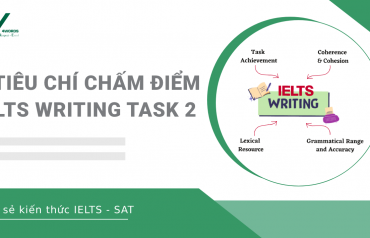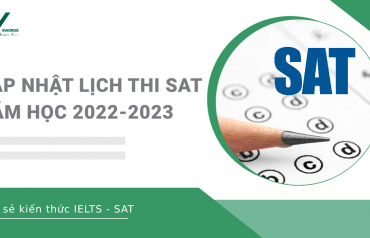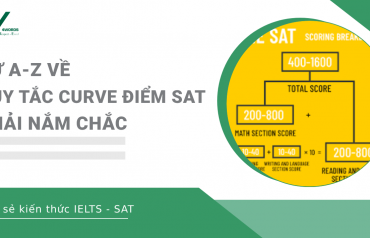Dạng câu hỏi Matching trong IELTS Reading và cách làm
Nhiều học sinh cảm thấy Matching là “đáng ngại” nhất trong IELTS Reading. Vậy đâu là phương pháp hiệu quả để tìm kiếm đáp án đúng? Cùng 4WORDS tiếp tục tìm hiểu sâu về dạng thức câu hỏi đọc hiểu này nhé.

Phần 4: Dạng câu hỏi Matching
4.1 Matching Headings
Với dạng bài này, thí sinh phải lựa chọn các tiêu đề được đánh bằng các chữ số la mã in thường(i,ii,iii, iv,…). Tiêu đề cần ứng đúng với nội dung chính của mỗi đoạn văn trong bài đọc. Trong các bài kiểm tra IELTS, số lượng tiêu đề thường nhiều hơn số lượng đoạn văn. Vì vậy, có một số tiêu đề sẽ không được dùng đến.
3 bước cơ bản để làm dạng bài Matching Headings
Bước 1: Câu chủ đề (Topic Sentence) có vai trò thể hiện ý chính của đoạn văn. Câu chủ đề thường nằm ở 1-2 câu đầu tiên hoặc 1-2 câu cuối cùng. Vì vậy chúng ta không nhất thiết phải đọc hết mọi câu trong đoạn để hiểu được nội dung.
Đọc 1-2 câu đầu tiên và 1-2 câu cuối cùng để suy luận nội dung chính của đoạn. Khi cảm thấy chưa tự tin, chúng ta mới cần tiếp tục đọc các thông tin chi tiết xuất hiện ở giữa đoạn. Có thể ghi chú lại các ý chính từng đoạn để tránh bị quên.
(Có một số bạn sẽ thắc mắc tại sao chúng ta không đọc tiêu đề trước. Rồi sau đó đọc đoạn văn sau? Lí do như sau. Thứ nhất, chúng ta tránh bị cuốn theo hướng nội dung các tiêu đề đã cho. Khi bị cuốn theo sẽ dễ nhầm đáp án. Thứ hai, sẽ tiết kiệm được thời gian khi không phải đọc tiêu đề nhiều lần. Dù có đọc tiêu đề trước – đoạn văn sau, chúng ta vẫn phải đọc lại tiêu đề lần nữa để tìm đáp án).
Bước 2: Đọc các tiêu đề đã cho, chú ý gạch chân các từ khóa. Trong phần bài này, các từ khóa là những từ xuất hiện nhiều trong bài.
Bước 3: Chọn tiêu đề phù hợp. Lựa chọn các tiêu đề có các từ khóa khớp với nội dung câu chủ đề đã ghi chú lại trong mỗi đoạn văn.
Ví dụ
Questions 1-5
Reading Passage has six sections, A-F.
Choose the correct heading for sections B, C, E and F from the list of headings below.
Write the correct number, i-xi, in boxes 1-4 on your answer sheet.
List of Headings
i MIRTP as a future model
ii Identifying the main transport problems
iii Preference for motorised vehicles
iv Government authorities’ instructions
v Initial improvements in mobility and transport modes
vi Request for improved transport in Makete
vii Transport improvements in the northern part of the district
viii Improvements in the rail network
ix Effects of initial MI RTP measures
x Co-operation of district officials
xi Role of wheelbarrows and donkeys
1. Section A
2. Section B
3. Section C
4. Section D
5. Section E
Makete Integrated Rural Transport Project
Section A
The disappointing results of many conventional road transport projects in Africa led some experts to rethink the strategy by which rural transport problems were to be tackled at the beginning of the 1980s. A request for help in improving the availability of transport within the remote Makete District of southwestern Tanzania presented the opportunity to try a new approach.
The concept of ‘integrated rural transport’ was adopted in the task of examining the transport needs of the rural households in the district. The objective was to reduce the time and effort needed to obtain access to essential goods and services through an improved rural transport system.
The underlying assumption was that the time saved would be used instead for activities that would improve the social and economic development of the communities. The Makete Integrated Rural Transport Project (MIRTP) started in 1985 with financial support from the Swiss Development Corporation and was co-ordinated with the help of the Tanzanian government.
Hướng dẫn giải đề
Bước 1:
Đọc 1-2 câu đầu tiên của đoạn văn và 1-2 câu cuối cùng. Sau đó suy luận xem đoạn văn này muốn nói ý chính gì. Nếu cảm thấy chưa tự tin với suy luận về ý chính, hãy đọc tiếp nội dung xuất hiện ở giữa đoạn văn.
1. Section A
The disappointing results of many conventional road transport projects in Africa led some experts to rethink the strategy by which rural transport problems were to be tackled at the beginning of the 1980s. A request for help in improving the availability of transport within the remote Makete District of southwestern Tanzania presented the opportunity to try a new approach.
The concept of ‘integrated rural transport’ was adopted in the task of examining the transport needs of the rural households in the district. The objective was to reduce the time and effort needed to obtain access to essential goods and services through an improved rural transport system.
The underlying assumption was that the time saved would be used instead for activities that would improve the social and economic development of the communities. The Makete Integrated Rural Transport Project (MIRTP) started in 1985 with financial support from the Swiss Development Corporation and was coordinated with the help of the Tanzanian government.
Đoạn 1: nói đến “a request for improving the transport…presented the opportunity to try a new approach” tại khu vưc Makete District of southwestern Tanzania.
Đoạn 2: giới thiệu “The Makete Integrated Rural Transport Project (MIRTP)”. Đây chính là phương án “a new approach” được nhắc tới phía trên.
Vậy ý chính của Section A là giới thiệu dự án “The Makete Integrated Rural Transport Project (MIRTP)” . Đây là dự án để cải thiện giao thông tại khu vưc Makete District of southwestern Tanzania.
Bước 2: Đọc các tiêu đề đã cho
Sau khi đọc tiêu đề đã cho, một số lựa chọn (i,v,ix,x) có khả năng là đáp án. Lý do là có sự xuất hiện của các từ khóa trong đoạn văn. Từ khoá bao gồm: MIRTP, request, a new approach to improve transport.
I MIRTP as a future model
v Initial improvements in mobility and transport modes
vi Request for improved transport in Makete
ix Effects of initial MI RTP measures
Phân tích các lựa chọn:
I MIRTP as a future model. Loại vì đoạn văn chưa hề đề cập đến rằng liệu MIRTP có phải là mô hình tương lai hay không.
v Initial improvements in mobility and transport modes. Loại vì chủ đề này quá chung trong khi đoạn văn đề cập tới MIRTP
vi Request for improved transport in Makete. Đúng vì chủ đề này bao gồm yêu cầu về việc cải thiện giao thông ở Makete. 2 câu đầu tiên đúng là nói về nhu cầu cải thiện. Câu cuối cùng nói về ví dụ phương án thực thi cho việc cải thiện đó.
ix Effects of initial MI RTP measures. Loại vì đoạn văn cũng chưa hề đề cập đến các tác dụng ban đầu của biện pháp MIRTP.
Bước 3: Chọn tiêu đề phù hợp.
Vậy đáp án là vi: “Request for improved transport in Makete”
Chú ý: Khi đã lựa chọn được một tiêu đề cho 1 đoạn văn, học sinh nên gạch bỏ tiêu đề đó. Vì mỗi tiêu đề chỉ sử dụng với một đoạn. Việc gạch bỏ tiêu để giúp các bước phân tích các đoạn văn sau được đơn giản, dễ dàng hơn.
2. Practice
Questions 1-5
Reading Passage has six sections, A-F.
Choose the correct heading for sections B, C, E and F from the list of headings below.
Write the correct number, i-xi, in boxes 1-4 on your answer sheet.
List of Headings
i MIRTP as a future model
ii Identifying the main transport problems
iii Preference for motorised vehicles
iv Government authorities’ instructions
v Initial improvements in mobility and transport modes
vi Request for improved transport in Makete
vii Transport improvements in the northern part of the district
viii Improvements in the rail network
ix Effects of initial MI RTP measures
x Co-operation of district officials
xi Role of wheelbarrows and donkeys
6. Section A
7. Section B
8. Section C
9. Section D
10. Section E
Makete Integrated Rural Transport Project
Section A
The disappointing results of many conventional road transport projects in Africa led some experts to rethink the strategy by which rural transport problems were to be tackled at the beginning of the 1980s. A request for help in improving the availability of transport within the remote Makete District of southwestern Tanzania presented the opportunity to try a new approach.
The concept of ‘integrated rural transport’ was adopted in the task of examining the transport needs of the rural households in the district. The objective was to reduce the time and effort needed to obtain access to essential goods and services through an improved rural transport system.
The underlying assumption was that the time saved would be used instead for activities that would improve the social and economic development of the communities. The Makete Integrated Rural Transport Project (MIRTP) started in 1985 with financial support from the Swiss Development Corporation and was coordinated with the help of the Tanzanian government.
Section B
When the project began, Makete District was virtually totally isolated during the rainy season. The regional road was in such bad shape that access to the main towns was impossible for about three months of the year Road traffic was extremely rare within the district, and alternative means of transport were restricted to donkeys in the north of the district. People relied primarily on the paths, which were slippery and dangerous during the rains.
Before solutions could be proposed, the problems had to be understood. Little was known about the transport demands of the rural households, so Phase I, between December 1985 and December 1987, focused on research. The socio-economic survey of more than 400 households in the district indicated that a household in Makete spent, on average, seven hours a day on transporting themselves and their goods, a figure which seemed extreme but which has also been obtained in surveys in other rural areas in Africa.
Interesting facts regarding transport were found: 95% was on foot; 80% was within the locality; and 70% was related to the collection of water and firewood and travelling to grinding mills.
Section C
Having determined the main transport needs, possible solutions were identified which might reduce the time and burden. During Phase II, from January to February 1991, a number of approaches were implemented in an effort to improve mobility and access to transport.
An improvement of the road network was considered necessary to ensure the import and export of goods to the district.These improvements were carried out using methods that were heavily dependent on labour In addition to the improvement of roads, these methods provided training in the operation of a mechanical workshop and bus and truck services. However the difference from the conventional approach was that this time consideration was given to local transport needs outside the road network.
Most goods were transported along the paths that provide short-cuts up and down the hillsides, but the paths were a real safety risk and made the journey on foot even more arduous. It made sense to improve the paths by building steps, handrails and footbridges.
It was uncommon to find means of transport that were more efficient than walking but less technologically advanced than motor vehicles. The use of bicycles was constrained by their high cost and the lack of available spare parts. Oxen were not used at all but donkeys were used by a few households in the northern part of the district. MIRTP focused on what would be most appropriate for the inhabitants of Makete in terms of what was available, how much they could afford and what they were willing to accept.
After careful consideration, the project chose the promotion of donkeys – a donkey costs less than a bicycle – and the introduction of a locally manufacturable wheelbarrow.
Section D
At the end of Phase II, it was clear that the selected approaches to Makete’s transport problems had had different degrees of success. Phase III, from March 1991 to March 1993, focused on the refinement and institutionalisation of these activities.
The road improvements and accompanying maintenance system had helped make the district centre accessible throughout the year. Essential goods from outside the district had become more readily available at the market, and prices did not fluctuate as much as they had done before.
Paths and secondary roads were improved only at the request of communities who were willing to participate in construction and maintenance. However the improved paths impressed the inhabitants, and requests for assistance greatly increased soon after only a few improvements had been completed.
The efforts to improve the efficiency of the existing transport services were not very successful because most of the motorised vehicles in the district broke down and there were no resources to repair them. Even the introduction of low-cost means of transport was difficult because of the general poverty of the district.The locally manufactured wheelbarrows were still too expensive for all but a few of the households.
Modifications to the original design by local carpenters cut production time and costs. Other local carpenters have been trained in the new design so that they can respond to requests. Nevertheless, a locally produced wooden wheelbarrow which costs around 5000 Tanzanian shillings (less than US$20) in Makete, and is about one quarter the cost of a metal wheelbarrow, is still too expensive for most people.
Donkeys, which were imported to the district, have become more common and contribute, in particular, to the transportation of crops and goods to market. Those who have bought donkeys are mainly from richer households but, with an increased supply through local breeding, donkeys should become more affordable. Meanwhile, local initiatives are promoting the renting out of the existing donkeys.
It should be noted, however, that a donkey, which at 20,000 Tanzanian shillings costs less than a bicycle, is still an investment equal to an average household’s income over half a year. This clearly illustrates the need for supplementary measures if one wants to assist the rural poor
Section E
It would have been easy to criticise the MIRTP for using in the early phases a ‘top-down’ approach,in which decisions were made by experts and officials before being handed down to communities, but it was necessary to start the process from the level of the governmental authorities of the district. It would have been difficult to respond to the requests of villagers and other rural inhabitants without the support and understanding of district authorities.
Section F
Today, nobody in the district argues about the importance of improved paths and inexpensive means of transport. But this is the result of dedicated work over a long period, particularly from the officers in charge of community development. They played an essential role in raising awareness and interest among the rural communities.
The concept of integrated rural transport is now well established in Tanzania, where a major program of rural transport is just about to start.The experiences from Makete will help in this initiative, and Makete District will act as a reference for future work.
Tương tự cho câu 2,3,4,5.
3. Section B:
““When the project began, Makete District was virtually totally isolated during the rainy season….”
….
“Before solutions could be proposed, the problems had to be understood….”
Phần mở đầu nói về thông tin chi tiết (tình trạng/vấn đề của quận Makete District). Sau đó tác giả đề cập đến nội dung chính của đoạn. “Trước khi đưa ra các giải pháp, chúng ta cần hiểu vấn đề là gì”.
=> Đáp án ii: Identifying the main transport problems
4. Section C
“Having determined the main transport needs, possible solutions were identified which might reduce the time and burden. During Phase II, from January to February 1991, a number of approaches were implemented in an effort to improve mobility and access to transport.”
=> đáp án là v: Initial improvements in mobility and transport modes.
5. Section D
“At the end of Phase II, it was clear that the selected approaches to Makete’s transport problems had had different degrees of success.”
=> Đáp án là ix “Effects of initial MI RTP measures”
6. Section E
Đáp án xuất hiện ở câu cuối cùng:
“It would have been difficult to respond to the requests of villagers and other rural inhabitants without the support and understanding of district authorities.”
=> Đáp án là x “Cooperation of district officials”
Trong bài viết tiếp theo, chúng ta sẽ cùng tìm hiểu thêm về những dạng câu hỏi còn lại trong IELTS Reading và cách làm nhé.
Các bạn có thể tham khảo thêm các bài viết trong chuỗi chủ đề này tại:
Tin Liên quan
5 mẹo đọc trong bài SAT nhất định bạn cần biết
Kinh nghiệm tổng hợp dưới đây sẽ giúp bạn vượt qua phần Đọc hiểu của bài thi SAT dễ dàng hơn đấy.
03/03/20207 lỗi sai trong IELTS Writing Task 2 ngăn bạn tới với band 7.0+
Trong IELTS, với phần thi Speaking, không hiểu câu hỏi này ta còn câu hỏi khác. Có hàng loạt câu hỏi và sự diễn giải đôi phần nếu cần thiết từ phía examiner để thí sinh tăng cơ hội...
25/01/2021Kỹ năng và chiến lược luyện IELTS Listening
Kỹ năng Nghe trong tiếng Anh là cực kỳ quan trọng trong bài thi IELTS. Bởi lẽ đây là kĩ năng tiềm năng để đạt tuyệt đối, nâng toàn bộ điểm tổng. Tuy nhiên, luyện tập nó lại không...
25/01/2021Hướng dẫn đăng ký thi IELTS
IELTS (English Language Test) là chứng chỉ Anh ngữ quốc tế được công nhận trên toàn thế giới. Tại Việt Nam chỉ có 2 trung tâm được phép cấp chứng chỉ IELTS là IDP và BC (British Council). Vậy...
12/11/2021Cách quy đổi điểm IELTS sang điểm thi Đại học
Bài viết này 4WORDS đã đề cập đến các cách quy đổi điểm IELTS sang điểm thi đại học. Đồng thời cung cấp chi tiết bảng quy đổi điểm IELTS 2021 mới nhất. Với một số trường đại học,...
23/04/2021








